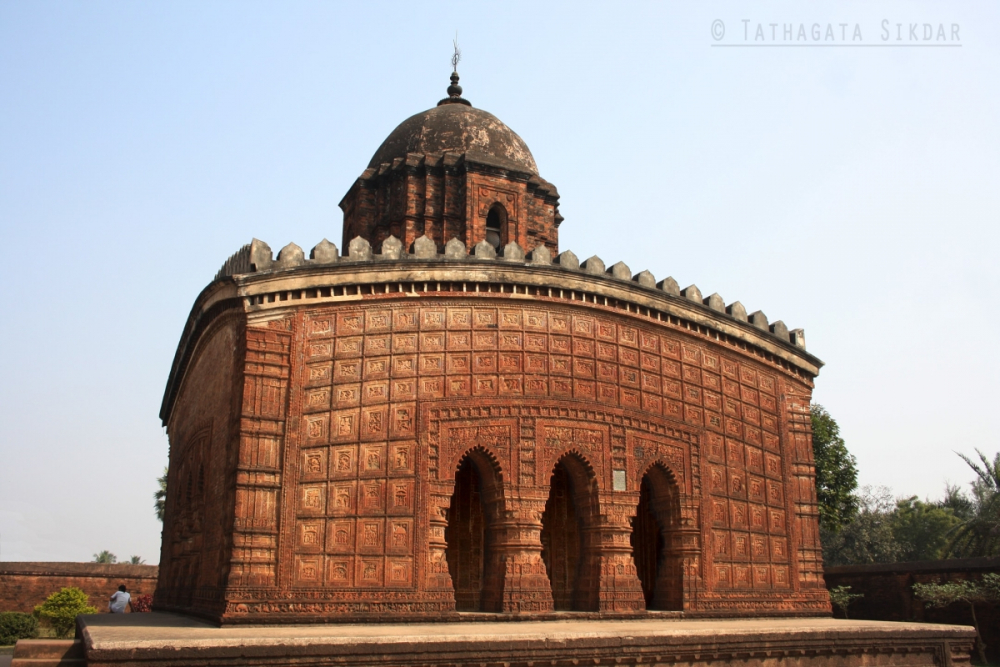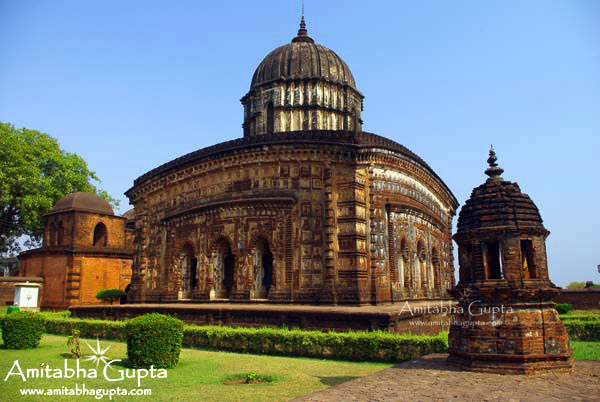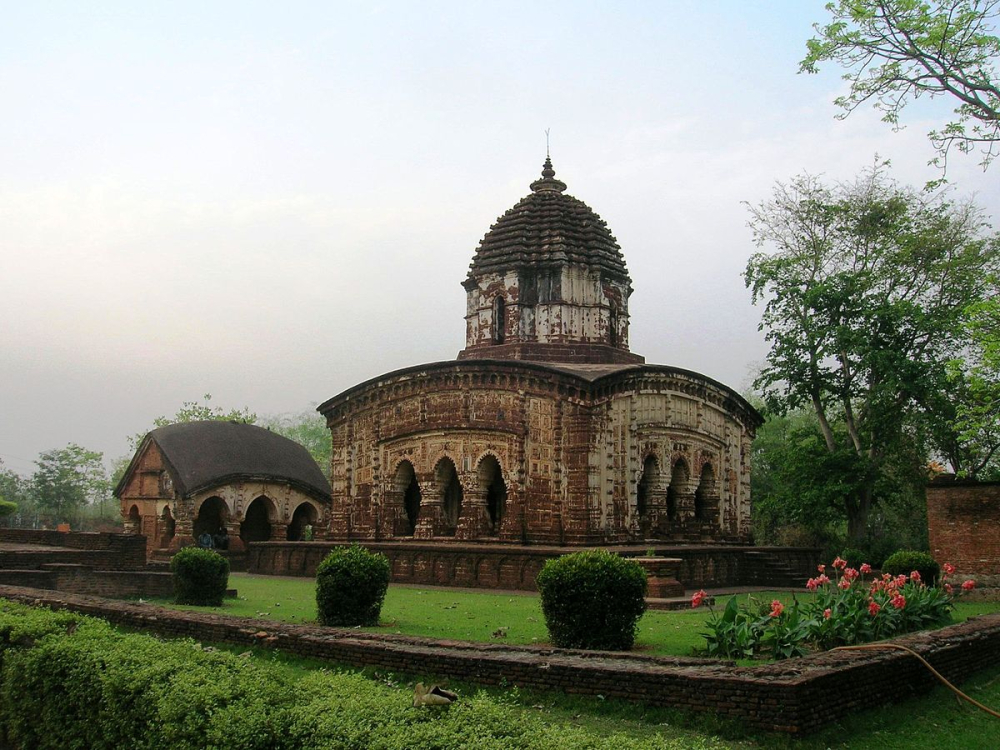Introduction
Bishnupur, a municipal town in the modern day Bankura district in West Bengal, was a centre of music, art, and architecture for hundreds of years. Among other things, the town is well-known for its terracotta temples, extensively embellished with carved and moulded terracotta decorations made from the locally available laterite clay. These temples are associated with the Gaudiya Vaishnava faith, dating back to seventeenth century.
Apart from its temple architecture, Bishnupur is also well-known for the craftsmanship of its terracotta figurines, pottery, jewellery, and other decorative artefacts. In recent years, artisans from Panchmura, a Bankura town not too far from Bishnupur, have also been churning out thousands of terracotta panels emulating the bas-reliefs of the terracotta temples of Bishnupur. These panels not only serve as mementos and curios for tourists to carry back home, but have also been increasingly used to decorate the facades of newer constructions, both religious and secular (Dasgupta 2000).
Origin and History
The origins of Bishnupur as a settlement are somewhat shrouded in mystery. Inscriptions dating back to Samudra Gupta’s period have referred to the locale, which came to be known later in the tenth century CE as Bishnupur, a small kingdom governed by local rulers who paid tribute to the Guptas. This was followed by a long period of obscurity, when the land shifted to and fro between being a minor independent principality and a feudatory state. Bishnupur eventually became the capital of the kings of the Malla dynasty, who ruled over a region known as Mallabhum, covering modern day Bankura, Onda, Bishnupur, Kotulpur, and Indas, till the first half of the twentieth century. During the reign of the Malla kings, which can be traced back to the seventh century CE, the region known as Mallabhum stretched further north to Damin-i-Koh in the Santhal Parganas, Midnapore in the south, Bardhaman in the east, and parts of Chota Nagpur in the west. It was in the sixteenth and seventeenth centuries, during the reign of Hambir Malla Dev, also known as Bir Hambir, the 49th king of the Malla dynasty, that Bishnupur began to draw interest from its neighbouring territories, both politically and culturally.
The origins of Bishnupur as a religious and cultural hub with its distinctive temple architecture is closely tied to the Gaudiya Vaishnava devotional movement of the sixteenth century in eastern India and Bengal in particular (then known as Gaud or Gaur). The bhakti saint and social reformer, Chaitanya Mahaprabhu (1486–1533), founded Gaudiya Vaishnavism, a brand of spiritualism marked by an emotive and intimate devotion to the Hindu god Krishna, the central deity of the tradition. Vrindavan—the mythical site where Krishna spent his youth, believed to be located in the woods by the river Yamuna in north India—held a profound fascination for devotees of the Vaishnava faith. Pika Ghosh argues that Bishnupur’s emergence as an important centre for Gaudiya Vaishnava is tied to the transformation of the forests of Bishnupur into a hallowed centre in an attempt to recreate a ‘Gupta Vrindavan’, that is, a hidden Vrindavan in Bishnupur (Ghosh 2002).
According to Gaudiya Vaishnava literature, Chaitanya picked six disciples who came to be called the Goswamis and established them at Vrindavan over the course of the sixteenth century. At his behest, the six Goswamis, who were the second generation of Gaudiya Vaishnava leaders, compiled the body of theological texts that had come to define their religious tradition. In the wake of Chaitanya’s demise and the waning popularity of the Gaudiya Vaishnava movement, the Goswamis chose Srinivasa Acharya, slated to become the next Gaudiya Vaishnava leader, to redeploy their energies in Bengal. He was provided a cartload of manuscripts inscribed with the essential principles of the tradition to help him accomplish this task. While travelling through Bishnupur, Srinivas lost these precious manuscripts placed under his charge. On tracing them to the local chief, Bir Hambir of the Malla dynasty, he visited Bishnupur and electrified the court by astutely narrating and elucidating on episodes from Krishna’s life. The raja was so deeply moved by Srinivas’s passion for Krishna that he fell at his feet and confessed to having arranged the theft of the manuscripts, mistaking them for worldly treasures. In a bid to make amends, Bir Hambir entreated Srinivasa and his fellow devotees to stay on and granted them the land and resources to create a sacred centre for Vaishnava devotion in the region.
This narrative, recovered from various Gaudiya Vaishnava texts, draws attention to Bishnupur’s political patronage of the Gaudiya Vaishnava faith, which helped the order flourish in this region and establish a seat of culture and religion based on the Vaishnava tradition. This alliance with the political authorities of Bishnupur meant that Gaudiya Vaishnavism would have a powerful influence on the distinctive styles of art, craftsmanship, and temple artistry that were on the verge of surfacing in the region. The consequent proliferation of temples in this region over the next century and a half, which British site surveys and administrative reports of the mid-eighteenth century estimate to be between 150 and 450 in number, is probably what gave Bishnupur its reputation as a religious centre (Ghosh 2002).
Terracotta Temples in Bishnupur
Structure and Design
Similar to the contouring of Vrindavan that had been carried out in the sixteenth century by Chaitanya and the Gaudiya Vaishnava devotees [1], temples burgeoned in Bishnupur, constructed to establish the ritual worship of images. The deities installed in these temples were named after the icons worshipped and enshrined previously at Vrindavan, notable examples being Madan Mohan, Shyam Raya, Radha Raman, Keshto Raya, Madan Gopal, Murali Mohan, Gopinath, and so forth. The narratives surrounding their miraculous discovery and revelation are also comparable to those of Vrindavan.

Fig.1: Madan Mohan temple (Image by Tathagata Sikdar- https://www.flickr.com/photos/tathagata_sikdar/6815791008)
Fig.2: Shyama Raya temple.
The temples in which these deities were installed, however, are distinctively atypical in that rather than turning to the architectural styles of Vrindavan for inspiration, they followed local architectural traditions and innovated on their own. These temples were conspicuously distinct from the Vrindavan temples—they were constructed on a new ratna style, reoriented to face south, departing from the nāgara custom of north India and the rekha style of facing east in the direction of the rising sun (Ghosh 2005). They had two storeys instead of one, with an additional shrine stacked over the conventional sanctum on the lower level. The shrine in the upper pavilion was reserved for special occasions such as festivals, leaving the lower sanctum available for daily worship. Novel also was the presentation of the dual axes of worship—these temples were provided with dual altars within the lower level sanctum itself. One altar was constructed on the traditional east-facing style of Hindu temples, and this deity would be ministered to by the priests of the temple. The other altar, which eventually came to hold greater importance, faced south towards the courtyard and nātmandir (entertainment hall), where devotees would gather to sing praises to Krishna and his heroics, and often spontaneously rise in dance during the ārati. This new temple form served the various ritual needs of the emerging Gaudiya Vaishnava community in Bengal.

Fig.3: Radha Shyaam temple. (Image by Amitabha Gupta- https://amitabhagupta.files.wordpress.com/2012/08/picture101.jpg)
Fig.4: Nandalal temple
The temples and monuments of Vrindavan drew heavily from the imperial Mughal style of the late sixteenth century. The architectural style of the Bishnupur temples, however, derived from the tradition that had developed under the sultanates that had ruled Bengal for the previous four centuries—interior vaulting, pointed arches with cusps, sturdy pillars with many facets, curved cornices, and terracotta decoration (McCutchion 1972). The continuities in the design style between these temples and the Islamic architecture of Qadam Rasul, a shrine constructed in 1519 in dedication to the footprints of the Prophet at Gaur, is articulated through certain shared features like the cubical base of the sanctum in temples such as the Madan Mohan temple (1694) (Fig.1), Shyam Raya temple (1643) (Fig.2), Radha Shyam temple (1658) (Fig.3), Nandalal temple (seventeenth century) (Fig.4), Radha Madhav temple (1747) (Fig.5), and so forth. Certain adaptations were introduced to tailor the structure to the needs of worship, such as the low structure with three cusped arches supported by thick faceted pillars at the entrance, rows of thin terracotta surface ornamentation, and the basic plan of a central chamber enclosed by shallow doorways.

Fig.5: Radha Madhav temple. (Image by Arnab Dutta- https://en.wikipedia.org/wiki/List_of_temples_in_Bishnupur#/media/File:Radhamadhab_Temple_Arnab_Dutta_2011.JPG)
Fig.6: Rasmancha
The temples also draw inspiration from the sloping thatched huts of the region; the curved cornices of these temples, a characteristic feature of this design, are derived from the bent bamboo eaves of cottages in the Bengali countryside. This feature occurs in combination with a number of basic designs. There is the char-chala design that consists of a four-sided roof coming to a point on a square base. A similar but smaller roof may be constructed on top of the char-chala like a tower to make an at-chala. There is the do-chala or ek-bangla design, which features a two-sided humped roof evocative of the curved cornice on an elongated base. The Rasamancha in Bishnupur is the earliest known temple in existence built in the ‘bangla’ do-chala style (Fig.6). When two such do-chala huts are attached one in front of the other, where the front acts as a porch and the rear as a shrine, the design is called jorbangla, as can be observed in the similarly named Jor Bangla or Keshto Raya temple (1655) (Fig.7). In the pancha ratna design, the roof is flatter than in the do-chala or char-chala, and has a tower in the centre which may be accompanied by four smaller turrets at the four corners. The number of storeys may be multiplied with the number of turrets in each corner from one (ek-ratna) to 25 (panchabingshati-ratna) (McCutchion 1972).
Fig. 7: Jor Bangla or Keshto Raya temple
Terracotta Decorations
Along with the innovations in form and structure, an exceptional feature of this kind of temple architecture is the use of terracotta facades. The temple walls are covered with terracotta panels recounting the life and exploits of Krishna, scenes from the Ramayana and the Mahabharata, and stories from the Vishnupurana (Fig.8). According to David McCutchion, the Bengal temple terracotta art that developed from the sixteenth to the nineteenth centuries, a development on the previous sultanate architecture of the region, forms a self-contained art tradition that is distinct from both the preceding styles and the succeeding ones. McCutchion says that even though terracotta decoration was in itself not a new practice, the finely chiseled carpet-like patterning of the terracotta facades of the Bishnupur temples was vastly different from the style of terracotta carving found in Buddhist monuments that used boldly carved and modeled laterite bricks. Terracotta itself ceased to be popular in the temple-building traditions of the later Pala and Sena periods: their broad brickwork acted as bases for stucco decoration alone.
Fig. 8: Panels with different carvings, Jor Bangla or Keshto Raya
Fig. 9: Krishna with Gopis
Even though scenes from Krishna’s life were most commonly sculpted on the terracotta plaques, there are also depictions of scenes from other Vaishnava texts and the larger body of the Vishnupurana, as well as legends of other gods and goddesses. The terracotta work on the Shyam Raya temple (1643), one of the oldest terracotta temples in Bishnupur, is a fine example of this. This temple has been constructed in the pancha-ratna style and is the most richly decorated of all the terracotta temples to be found in the region—every inch of the temple from the interiors to the archway and from the vaulting inside to the towers on the roof are sheathed with fine terracotta work. There are innumerable small plaques embellished with images based on themes such as Krishna embracing Radha or playing his flute to her, Krishna’s battle with Indra for the parijat tree, and Krishna between two gopis under an elaborate canopy (Fig.9). These images are bordered by a profusion of small rhythmic figures and floral and vegetal motifs. Above the archways are panoramic battle scenes depicting gods, demons, warriors, and heroes. Scenes from Puranic legends, the Ramayana, and Krishnalila adorn the rows below, and the plaques at the very bottom depict more contemporary scenes of the raja going to battle or proceeding in his palanquin.
Fig. 10: Bhishma on a bed of arrows
The terracotta on the nearby Keshto Raya temple, also famously known as the Jor Bangla temple, built only 12 years after the Shyam Raya temple and with the patronage of the same raja, is just as lavish as its predecessor. The subject matter is also largely similar, but the layout is more intrepid and systematic. The different rows of illustrations depict a single, linear narrative each, with entire rows being taken up by chronological depictions of Krishna’s life from the nursing of Krishna and Balaram to Krishna and Balaram fighting the King’s wrestlers in Mathura, warriors confronting each other on chariots in the battle of Kurukshetra highlighting evocative scenes like Bhishma lying on a bed of arrows (Fig.10), scenes from the Ramlila, and so forth.
The stories surrounding Krishna’a life and the legends regarding his miraculous deeds were integral to the way the Gaudiya Vaishnava movement unfolded and proliferated in Bengal during the sixteenth and seventeenth centuries. The artistry displayed in the terracotta temples is an indication that alongside devotional songs and dramatic performances, a visual vocabulary for communicating the episodes of Krishna’s life also emerged. Manuscript copies of the Bhagavata Purana, a text regarded as a revelation in the Vaishnava tradition, were lavishly adorned with images depicting these episodes, bringing to light the earliest efforts at establishing pictorial conventions. These depictions similarly came to adorn the brick surfaces of Krishna temples in sixteenth and seventeenth century Bishnupur—a visual narrative of the life story of the deity housed in the temple (Ghosh 2005).
The temple imagery, by showing Krishna’s miraculous feats, his dramatic and violent confrontations, and his amorous encounters, created compelling visual sequences meant for a largely illiterate audience. It may be conjectured that the terracotta panels acted as visual aids accompanying the narration of a priest or community elder. The practice still exists whereby adults and guides recount epic and Puranic tales to children and visitors, using the panels to bring alive the scenes for the listener’s imagination. Together with devotional music and drama, the terracotta panels can be seen as part of a collective artistic tradition that helped reinforce Gaudiya Vaishnava narratives and the theological messages embedded in them by evoking complete sensory participation in the form of sight, sound, action, and perhaps even smell and taste in the form of flowers and offerings. The profusion of these images and their selective deployment in the overall spread of the Gaudiya Vaishnava faith reveal both an attempt to define the texts and practices of the faith, as well as to put Bishnupur on the map as an emerging centre for pilgrimage and devotion during the sixteenth and seventeenth centuries.
Notes
[1] Pika Ghosh writes in Tales, Tanks and Temples that Gaudiya Vaishnava literature from the seventeenth and eighteenth centuries credit Chaitanya with reviving Vrindavan and restoring it as the abode of Krishna’s divine play. This divine play, as described in the tenth century Bhagavata Purana, a text regarded as revelation in the tradition, is believed by Vaishnavas to be reenacted perpetually in these groves.
Bibliography
Dasgupta, Chittaranjan. 2000. Bharater Shilpa-Sanskritir Patabhumikay Bishnupurer Mandir-Terracotta. Bishnupur.
Ghosh, Pika. 2002. ‘Tales, Tanks, and Temples: The Creation of a Sacred Center in Seventeenth-Century Bengal’, Asian Folklore Studies Vol. 61.2: 193-222.
Ghosh, Pika. 2005. ’Narrating Kṛṣṇa’s Biography: Temple Imagery, Oral Performance, and Vaiṣṇava Mission in Seventeenth-Century Bengal’, Artibus Asiae Vol. 65. 1: 39-85.
Mallik, Abhaya Pada. 1921. History of Bishnupur Raj: An Ancient Kingdom of West Bengal. Kolkata.
McCutchion, David. 1967. The Temples of Bankura District. Kolkata: Writer’s Workshop.











